2015年10月08日
CSM Foundation Invited to Collaborate in Italy
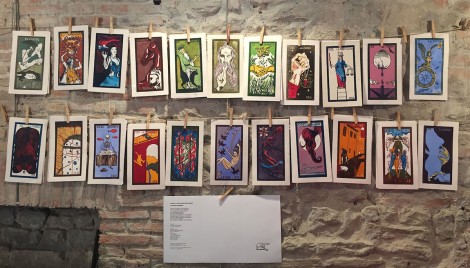
In the Summer of 2015 a group of specialist Graphic Design Foundation students were invited to Opificio della Rosa, a castle in Italy, to take part in a collaborative printmaking residency project with students from the University of Fine Art in Rome.
The students took part in a 12-day experimental workshop exploring colour woodcut and letterpress techniques while living and working together in the ancient castle. They reinterpreted and developed a new setof Major Arcana tarot and together created a deck of the 22 hand crafted cards.
The project was coordinated by lecturers Maria Pina Bentivenga University of Fine Art in Rome and Umberto Giovannini from Central Saint Martins in London.
記事はこちら⇒ CSM News
投稿者 unicon : 11:17
2015年08月31日
Google's interactive art installation turns random words into poetry
大学と企業の共同プロジェクトが盛んなロンドン芸術大学。
セントマーチンズのMA Narrative Environments を今年修了した木村さんがコンペで選ばれたプロジェクトは何とあのGoogle様!規模が違うぜ、セントマ!
昨年から動いていたこのMA Narrative EnvironmentsとGoogleのプロジェクトの実際のインスタレーションがオフィシャルに公表されました。
以下、木村さんからの補足説明とメディア掲載記事です。
CSMのマスターの中でもナラティブは実践的なプロジェクトが多く、今までも多くのエキシビションやイベント、コマーシャルなものまで幅広く企業や団体とコラボレーションしてきたのですが、中でも今回はGoogleとのプロジェクトでコンペ形式で行われたので内容的にも大変面白いものになったと思います。
概要を少し説明させていただくと、、、
まずGoogle UKがキングスクロスに越してくるので、KXコミュニティにSay helloする目的で工事中の壁にインスタレーションを作るというブリーフでした。リサーチから初めて、コンセプトとデザインまで私達でやったのですが、(ファブリケーションがGoogleという感じです。)最終的なデザインは、キングスクロスに来た人全てが参加できる(エリアが現在都市再開発をしているので実際にはコミュニティなどないという論結)マイクに話した言葉がランダムにディスプレイに表示されて一つのポエトリーをつくるというCollective Art Experienceです。
リファレンスとインスピレーションににRail Stationのサインシステム、Speaking Tube、 Exquisite corpes、俳句などを使っています。
ロケーションもキングスクロス駅でてすぐ、セントマに向かう途中なので、現役セントマ生はもちろん、今年から入学するユニコン生たちにいいモチベーションになればと思います!(6ヶ月ほど設置される予定です。)
Google has unveiled an interactive art installation that turns random words into poetry that then appears on an electronic billboard in north London.

Called Poetrics, the installation is made up of 17 LED panels that display words spoken into microphones placed at street level as randomly created poetry.
It has been placed on the hoardings around the development site of Google's new Kings Cross offices for passers-by to interact with, and is promoting the Knowledge Quarter's upcoming Curious Arts Festival.
.jpg)
The project is the result of a competition run in partnership with University of the Arts London's Central Saint Martins college to create an "interactive experience for the Kings Cross community".
The installation uses Google's voice search technology and the Google Speech platform to recognise what is being said, and then placing it within the newly created poetry.
“Thousands of people pass by our development site at Kings Cross every day so we wanted to create an experience which would help bring them together. We loved the idea from the students to produce randomly created poetry as passers-by talk into the installation.”
– PETER BARRON, GOOGLE
.jpg)
Laura Ventura Ricart, an MA Narrative Environments student and part of the Poetrics team said:
“We saw Poetrics as an opportunity for people to have a collective and meaningful experience playing with language and the absurd, just as the Dada did in their surrealist game 'the Exquisite Corpse'. Poetrics' interactive wall collects and assembles words spoken by the people of Kings Cross and turns them into random poetry made by all.”
– LAURA VENTURA RICART, STUDENT
記事はこちら⇒ itv NEWS
投稿者 unicon : 15:48
2015年06月02日
Akiko Shinzato Awarded Swarovski Award 2015
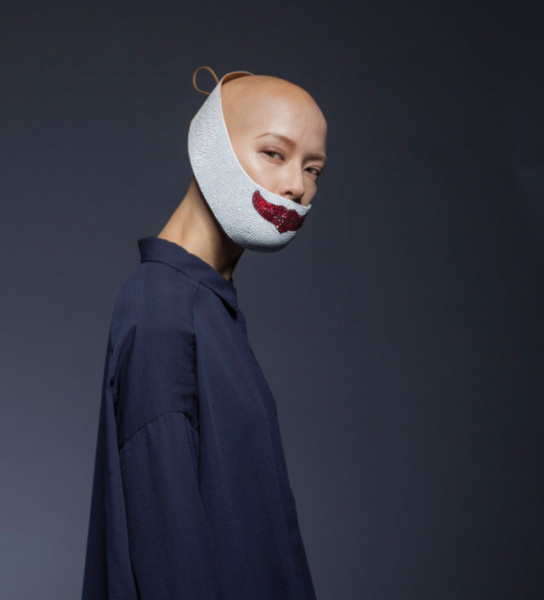
Akiko Shinzato was awarded the Swarovski Prize for 2015, at the V&A connects event last Friday. Special mentions were given to Dennis Song and Jessica Pass.
Coinciding with the Savage Beauty exhibition at the Victoria and Albert Museum, third year Central Saint Martins BA Jewellery Design students collaborated with Swarovski on Alexander McQueen inspired pieces for this year’s Swarovski Award project.
More details and images from the evening are covered in an article by 1 Granary magazine. This year’s award was judged by the team from Swarovski, and Sonnet Stanfill, curator at the V&A.
The 10 shortlisted finalists work is on display in Gallery 25 until the 31st May 2015 as The Swarovski Design Project.
記事はこちら⇒ https://csmbajewellery.wordpress.com/2015/05/13/akiko-shinzato-awarded-swarovski-award-2015/
投稿者 unicon : 12:11
2015年04月15日
セントマーチンズのマジックコース“Orientation to Art and Design”の授業料が値上がりします
過去20年間のロンドン芸大ファウンデーション・コースへの合格率はほぼ100%。
セントマのファウンデーションに限っても99%以上の実績を持つマジックコース。
それがセントマーチンズのOrientation to Art and Design (通称:オリエン)。
ロンドン芸大にしては珍しくここ3-4年授業料がほとんど変わらなかったオリエンテーションコースも2015年10月のコースよりついに値上がりします。
旧授業料: 3975ポンド ⇒ 新授業料: 4495ポンド
2015年6月22日スタートのオリエンは3975ポンドです。
6月22日からのオリエンは現在も申込みを受け付けていますので、受講ご希望の方はユニバーシティ・コンサルタンツ東京事務所までご連絡ください。
〜〜〜〜〜〜〜お問い合わせはここへ 〜〜〜〜〜〜〜
ユニバーシティ・コンサルタンツ東京事務所
住所:〒150-0045 東京都渋谷区神泉町1-11
電話 : 03-5728-6330
メール : mail@unicon-tokyo.com
☆**‥…★…‥**☆◆☆**‥…★…‥**☆◆☆**‥…★…‥**☆◆☆**‥…★…‥**☆
オリエンテーションコースの体験記
【コース体験記】武内さやさん(19歳)雨にもIELTSにも負けず 平成女子高生のロンドン奮闘記】
http://www.unicon-tokyo.com/courses/archives/2012/12/19ielts_1.html
【この人に聞きました:メディア掲載】File17. 田崎志佳さんがメディアで紹介されました!http://www.unicon-tokyo.com/interview/archives/2014/06/file17.html
【オリエンテーション@セントマ 塩川さん】
http://www.unicon-tokyo.com/courses/archives/2013/01/post_2.html
【この人に聞きました】“やる気と勇気とお金がキーワード 100万円で人生を変えた人たち” 雑誌「Lips」掲載記事 塩川彩さん
http://www.unicon-tokyo.com/interview/archives/2013/10/file14.html
【Artscom @CSM オリエンテーション 西久保まりさん】
http://www.unicon-tokyo.com/courses/archives/2009/06/artscomcsm.html
☆**‥…★…‥**☆◆☆**‥…★…‥**☆◆☆**‥…★…‥**☆◆☆**‥…★…‥**☆
投稿者 unicon : 10:24
2015年04月10日
The dA-Zed guide to Alexander McQueen
Runway cyborgs, bum-baring jeans and golden showers: in honour of Savage Beauty’s upcoming opening, we break down the legend in 26 letters
Savage Beauty has finally come home to the city that birthed the man. Opening at the V&A five years after the fashion iconoclast’s death, the Alexander McQueen retrospective promises a groundbreakingly inclusive tribute to the designer and his vision. Whittling down the world of fashion’s most controversial, far-reaching and future-facing designer into a 26-point love letter feels, inevitably, too small; even in his quietest moments, McQueen’s romantic offensive against fashion’s prevailing mood for minimalism was unfailing. So here, to mark the exhibition’s opening, is just one narrative among so many: our critical guide to the clothes, the shows, the collaborators, and, connecting everything, the fantastical playground of inspirations that one can just about make out in the dark.
A IS FOR THE ASYLUM
McQueen at his theatrical best. His SS01 tableau saw models trapped inside a glass cube, with the audience outside looking in – but the models couldn’t see out. A psychiatric ward in the guise of a fashion presentation, the inmates wore hospital headbands with their feathered creations. The finale revealed another cube within the ward, within which lay McQueen’s stark pièce de résistance: a Rubenesque figure, reclining nude, her face concealed by an iron mask with tubes and her body surrounded by fluttering moths.
B IS FOR BUMSTER
We can probably lay the blame for the low-slung jeans of the early 2000s at the feet (or rather the waistline) of the McQueen bumster. First seen in trouser form in the designer’s first collection, it was reincarnated in later years – as a black silk taffeta skirt in AW95’s Highland Rape collection, for example. As McQueen told the Guardian in 1996, it wasn’t about builder’s behinds: “I wanted to elongate the body...The bottom of the spine – that’s the most erotic part of anyone’s body, man or woman.”
C IS FOR CYBORGS
As the millennium approached, designers turned to technology to see what the fashion future held – and McQueen, by then at Givenchy’s helm, was no exception. For AW99’s Haute Couture collection, McQueen’s LED light-up creations were a cyberpunk future shock for couture’s elite.
D IS FOR DAVID BOWIE
“Are you gay and do you take drugs?” That’s how David Bowie’s frank interview with Alexander McQueen begins in issue 26 of Dazed. McQueen designed the costumes for the Thin White Duke’s tours in 1996-1997, as well as the iconic Union Jack coat he wore on the cover of the Earthling album.
E IS FOR 'ECLECT DISSECT' COLLECTION
Marking McQueen’s second collection for Givenchy, AW97 was created in close collaboration with set designer Simon Costin – a pairing that worked to redefine the fashion show format time and time again. Located in a Paris medical school, McQueen’s vengeful ghosts wore resin animal skulls as shoulderpads and taxidermy as headdresses in a procession that married East and West in unprecedented combinations. As McQueen told Numero in 2002, “My idea was this mad scientist who cut all these women up and mixed them all back together.”
F IS FOR FASHION-ABLE
McQueen’s designs were always a riposte to normative beauty, but it was in a guest-edited issue of Dazed in September 1998 that he confronted convention most profoundly. His Fashion-able cover story, in collaboration with Nick Knight and Katy England, featured models with varying physical disabilities and specially commissioned designs from Rei Kawakubo, Hussein Chalayan and Philip Treacy. But how would critics react to fashion articulating a subject often left to silence? As Susannah Frankel said of the shoot, “The brilliant thing about the designer – one of the many, many brilliant things about the designer – was that he didn’t care one iota about what anyone else would think.”
G IS FOR THE GOLDEN SHOWER
McQueen’s SS98 show The Golden Shower – or Untitled as it was known to its outraged corporate sponsors – was a memorable feat of two distinct halves. In the first, sharp tailoring grew steadily sheerer to reveal the skin underneath. In the second, the yellow-lit rain fell, soaking models’ all-white outfits as the liquid underneath the runway steadily grew to an inky black.
H IS FOR HIGHLAND RAPE
Inspired by the “ethnic cleansing” of the British Forces in the Scottish Highlands in the 18th and 19th centuries, McQueen’s fourth collection revealed his strong ancestral pride as well as his strong statements on femininity that would continue to be misconstrued by critics throughout his career. Models were battered and bloodied, and clothes fell off their frames – but, for those who were paying attention to the clothes, the precise tailoring and early appearance of the Bumster made a strong statement of his burgeoning house codes.
I IS FOR ISABELLA BLOW
An enduring collaboration that set the standard for muse/artist relationships, Isabella Blow is credited for discovering McQueen and accompanying him every step of the way into the heart of the fashion establishment. She bought his entire graduate collection for £5000, paying it in £100 instalments. Blow is even to thank for his very moniker – she reportedly persuaded him to go by his middle name, rather than ‘Lee.’
J IS FOR JACK THE RIPPER (STALKS HIS VICTIMS)
This was title of McQueen’s 1992 graduate collection from the Central St Martins MA course, overseen by the late Louise Wilson. It introduced style tenets that would shadow his entire ouevre – historical narratives, and a constant dance with death and decay. The latter obsession was reified in one frock coat, which contained just-visible human hair between the fabric and the lining (his own, by all accounts).
K IS FOR KATY ENGLAND
Katy England was McQueen’s closest collaborator for more than a decade. They met in 1994, when McQueen approached her in a bead shop: asking, according to a later Guardian interview with the stylist, “Are you Katy England? Do you want to go for a cup of tea?” The designer’s right hand woman since SS95’s The Birds show and right through the Givenchy years, her role in those early making-it-up-as-they-went-along days established one of fashion’s most fruitful creative affiliations.
L IS FOR LONDON
Unlike the Met’s 2011 exhibition, the V&A’s take features a new gallery: curated by England, it showcases 10 designs from McQueen’s early years in London. His East-End origins, complete with a cabbie for a father, contributed to the media myth-making around the “hooligan” of haute couture. It was label that McQueen part-despised, and part played up to – but for those who looked beyond the hype, London was as much an integral part of McQueen’s design DNA as it was his public persona.
M IS FOR "MARKS AND SPENCER"
Historians of McQueen’s fabled fashion history needn’t panic – you haven’t missed a one-time high-low collaboration with the British high street establishment. In conversation with David Bowie in Dazed & Confused, McQueen is asked if he prefers “Armani and Versace” His response? “Marks and Spencer” – three little words that, as ever, proved McQueen’s talent for sound bites as well as his commitment to fighting corporate ennui in fashion (no matter whom he might offend in the process).
N IS FOR NATIONHOOD
In an era where fashion’s homogeneity declared local colour to be distinctly beyond the pale, McQueen emerged as a designer who was fiercely proud of his heritage. He was also able to make that heritage feel new again. Inspired by his family roots that traced back to the time of the last Jacobite rising, his historical viewfinder highlighted events of our cultural legacy that most would rather be left unturned. Highland Rape’s reference to Britain’s atrocities in Scotland is an early example, but the vision was developed to emotional and technical completion in Widows of Culloden: the show, for AW06, that conjured images of tartan-clad Scottish heroines with fierce warriors for ancestors.
O IS FOR OUT OF THIS WORLD
With his artistic vision by then irrevocably tied to commercial backing – its rewards, and its discontents – McQueen proved his ability to break into unprecedented, even extra-terrestrial territory for his final, finished collection. Dubbed Plato’s Atlantis, SS10 was the first show to be live streamed online, in collaboration with SHOWstudio. It spoke of something other than human: the collection’s digitally printed dystopia felt wholly alien even while it proved a biological match for the fashion world’s fauna.
P IS FOR PEPPER'S GHOST
Widely held – for those lucky few in attendance – to be McQueen’s most astounding runway moment, the finale of AW06 revealed a dancing Kate Moss who was both there and not there. The state-of-the-art hologram, which flickered into being for a few seconds before disappearing, was created by Baillie Walsh using the optical technique known as Pepper’s Ghost – so-called for being first put into practice by the alchemist John Henry Pepper in the mid-19th century.
Q IS FOR QUEERING HOUSE CODES
In 1996, Givenchy was safe: its tenets were elegance, understatement and refinement. That is until a new maestro was appointed who was determined to provoke. He would hold the role until 2001, in which time house signatures would be subverted and show formats transformed into performance art: his haute couture show for AW99, for example, replaced models with futuristic plastic mannequins, made to seem alive by springing from the ground, rotating and returning to the darkness.
R IS FOR ROBOTICS
In a SS99 collection inspired, in essence, by the Arts and Crafts movement, the finale cemented McQueen’s reputation as equal amounts performance artist and designer. Inspired by a Rebecca Horn installation of two shotguns firing blood-red paint at each other, the audience bore witness to a technological attack on model Shalom Harlow: two industrial, robotic arms spray-painting her rotating frame with increasing aggression, a symbolic act that spoke of the act of creation itself.
S IS FOR SARAH BURTON
Manchester-born, London-made designer Sarah Burton first interned at McQueen in 1996; after her mentor and friend’s death, she took on what many saw as the insurmountable task of continuing his legacy. But continue it she has, with the kind of deep understanding of the McQueen DNA that has given her authority to take it forward: the dark romanticism remains, but filtered through a new lightness.
T IS FOR TAILORING
Before Central Saint Martins, McQueen pursued a four-year stint at Savile Row, establishing the designer’s confidence in cut and precision that would come to define his output from his degree collection to his last. A popular narrative of his training at the coat-tails of the upper classes in his early years prevails, though to ask McQueen himself, the signature sharpness was innate. As he once said, “I think to know about colour, proportion, shape, cut, balance, is part of a gene.”
U IS FOR THE UNDEAD
From the very beginning, McQueen’s women-muses have been vengeful ghosts and unearthed corpses. A taste for the macabre infused throughout his collections, whether articulated out of 19th century history books or darkness closer to home. In AW98’s It’s a Jungle Out There show, overt animal references were an opportunity to muse on the ephemerality of human life, too – one jacket depicts Jesus on the cross. But the McQueen undead always reeked more of vengeance than they did an early grave – for AW01, one model nimbly dragged a golden skeleton with her heel.
V IS FOR VICTORIANA
Throughout his own reign at the helm of a great British fashion empire, McQueen’s creations continually returned to the aesthetic tropes of an antecedent century: Victorian and Edwardian themes pepper his oeuvre, from his first Jack the Ripper-inspired collection to the crinolined creatures of his critically acclaimed AW08 offering, a collection that told a story of colonial romance in India.
W IS FOR WOODLAND CREATURES
McQueen’s affinity with the natural world led to the continued appearance of animal – and animalistic – tropes in his (ostensibly) human-populated world. AW97’s It’s a Jungle Out There brought us his signature gazelle’s horns, twisting from heads and from the shoulders of jackets. Later, SS09’s Origin of the Species-inflected collection played on the signatures of all members of the animal kingdom – and even featured taxidermied creatures as its backdrop, with McQueen appearing dressed in a rabbit outfit for the finale.
X IS FOR XENOPHILIA
McQueen’s fierce Brit boy persona was always offset by his xenophilic tendencies: he mingled Spanish matadors, Indian weddings and Eastern promise, often within a single show and sometimes, remarkably, within a single, agenda-setting garment. Asia provided a fruitful inspiration at many points, with the McQueen kimono becoming a signature of the designer’s oeuvre – even, as demonstrated in SS15’s celebration of Japonism, as extended to Sarah Burton’s tenure today.
Y IS FOR YOUTH CULTURE
“I draw inspiration from the streets of the city, from the kids in Hoxton, to the punks in Camden, to a chic lady walking down Bond Street.” So said McQueen, speaking to Dazed ahead of launching his youth-culture focussed diffusion line in 2006. Taking the mainline’s signature tailored tweeds and diffusing it through the denim and leather uniforms of London’s teenagers, the collection proved McQueen’s apprehension of the styles on the ground – even while his main collection reached new conceptual heights.
Z IS FOR ZEITGEIST
Putting the public narratives around the man himself aside, there’s another reason why McQueen has become part of a nation’s cultural consciousness: his talent for launching a trend, with all the thousands of imitations that such a knack would connote. A potted history of trends that peppered the 1990s and 2000s, however regrettable they may be now, read like a inventory of McQueen originals: low-slung jeans (those bumsters), pirate boots (SS03), digitally engineered prints (SS09), and, of course, SS10’s Armadillo heels, which surely spawned the noughties’ obsession with impossible heights in footwear.
記事はこちら⇒ DAZED
投稿者 unicon : 15:41
2014年05月21日
Remembering Louise Wilson, Central Saint Martins' Legendary Professor【VOGUE.com】
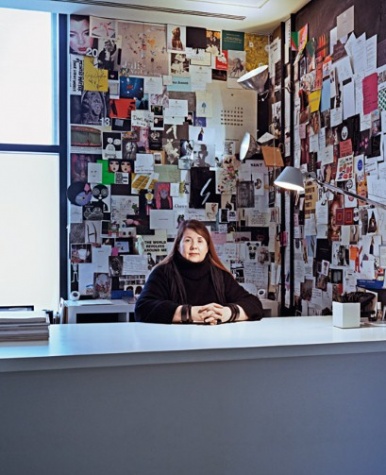
The sudden loss of Professor Louise Wilson, OBE, has left dozens of London designers inconsolable this weekend, as well as the many more she taught who populate the design studios of New York and Paris. “Without Louise I would not be here,” said Christopher Kane yesterday. That simple emotion is echoed over and over by the alumni who have had their talents forged in the furnace of Professor Wilson’s critiques in her Central Saint Martins office. “Louise had a special talent to see right inside of us all,” said Mary Katrantzou, who recalls the terrifying utterance directed toward every newcomer who quaked in front of her desk: “Impress me.”
Wilson was famously hard to impress. She had seen and retained it all about fashion, since she herself has been a childhood reader of her mother’s Vogues, and then graduated, a few years after John Galliano, from the then Saint Martins School of Art in 1986—the high clubbing/fashion/music years of which she took full advantage. No reference escaped her and no plagiarism was tolerated, but what drew Wilson to persist was the possibility that some new flash of originality would eventually materialize from within her students’ brains. Anyone who expected her to serve up creative orders on a plate was in for one of Wilson’s famous slap-downs. A politer variant was her declaration: “We don’t know what we want, but we know it when we see it.”
Laziness could make her irate. “I’ve seen Louise drop-kick a mannequin across the studio when she was frustrated with a student’s work,” said Richard Nicoll, “And there are a plenty more stories like that.” Once, a student was expelled from her office at such velocity that his scarf was slammed in the door. The professor continued her work late into the evening and was surprised to see a figure huddled on the floor outside. He had been too afraid to knock and ask for his scarf back five hours earlier.
Nevertheless, what drove Wilson was, as she said, the “privilege” of being around youth. Her lasting friendships with the designers she really rated was her reward. “She would tell me everything like a mother would—if my hair looked shit, if she liked something I did. I found her very ‘mother-y,’ ” said Roksanda Ilincic. Self-laceratingly, Wilson would never boast or make assumptions about her entitlement to invitations, yet she could easily have laid claim to being the generator of what is being dubbed the current "Golden Age" of London fashion. Two dozen of the women’s and menswear designers who show in London are alums of Central Saint Martins’ MA program, including: Kane, Katrantzou, Jonathan Saunders, Ilincic, Nicoll, Marios Schwab, Simone Rocha, Thomas Tait, J. JS Lee, Michael van der Ham, and Marques’ Almeida. The success of the first generation of new professional British designers who sell globally at a luxury level is linked directly back to the visionary who saw each person as an individual and had no taboos or snobbery about what constitutes fashion. London Fashion Week became characterized by variety, energy, and surprise for onlookers, and for the ones inside it, there was the unique London-community camaraderie amongst those who were driven to define themselves by Wilson.
What students saw when facing their professor was not just her impassive, black-clad, all-seeing presence, but the pin board behind her desk in her office, famously covered with show invitations, thank you notes, and quotes she liked. That wall was testament to how so many people adored and relied on her over 22 years as the MA course leader, including Alber Elbaz at Lanvin, who was one of the beneficiaries of the fact she became an unofficial matchmaker between houses and graduates. “The people Louise sent me were always the best, always the ones who have stayed. I loved Louise,” he said.
Accolades and recognitions came her way. In 2008, she was honored to receive the Order of the British Empire for Services to Fashion and Education from the Queen, and in 2013 was almost as gratified to receive a happy birthday shout-out from Kanye West at his gig at the Hammersmith Odeon. Her current students, also there, cheered on, boasting “Happy Birthday Louise Wilson!” on the student website 1granary.com. West had petitioned her as a student, coming to see her at the college with plans for his line. She was not unduly impressed, and sent West away, though since the fanship also ran the other way, (Wilson loved rap, Motown, African-American music and culture in general), the professor and Yeezus formed a funny, good-natured, mutual admiration.
Wilson leaves her Ghanaian partner, Timmi Aggrey, and their 23-year-old son TJ. They, and the wider family of fashion she created, are deeply mourning her today. Current students at Central Saint Martins are planning a vigil in her memory tomorrow.
記事はこちら⇒ http://www.vogue.com/vogue-daily/article/louise-wilson-tribute-central-saint-martins-professor/#1
投稿者 unicon : 12:33
2014年02月18日
Our Top Picks From Central Saint Martins MA 2014 Collections【GRAZIA】
Every year the Central Saint Martins postgraduate show is watched very closely - could we be witnessing the next Alexander McQueen or Christopher Kane? The MA collections always push things to the limit, with bonkers experimentation, often going where commercial designers wouldn't. This year's show was no exception.
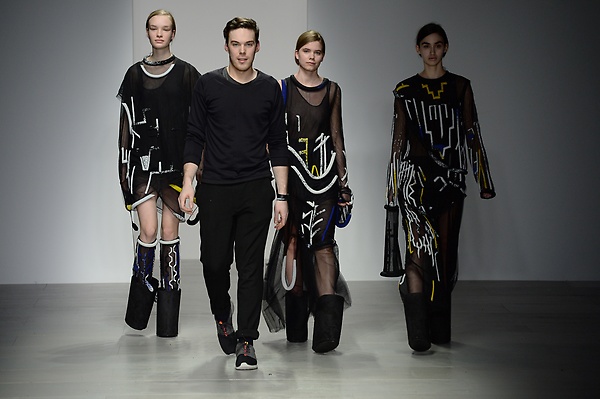
From Teruhiro Hasegawa's opening looks that stalked like gothic ninja ghosts to huge metallic tent-like dresses from Nayuko Yamamoto, fit for Glasto 2069. A big feature on the L'Oreal Professional runway this year was the weave. Serena Gill crafted loose-knits of long beads and stripes of mohair (that clashed wonderfully over Perspex lampshade skirts), whilst Jessica Mort deconstructed striped AirTex shirts and wove the shards back together again. Alongside these, Graham Fan showed tinsel woven roll necks and beautiful basket weave metallic skirts and Anita Hirlekar's multicoloured yarn splashed across black mesh like bright brush-strokes.
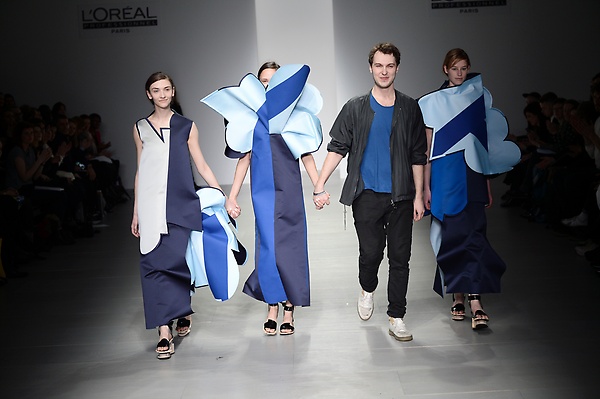
This year's panel judge Christopher Kane found it impossible to choose a winner for the L'oreal Professional Creative Award from the selection and we would have done too. Ever ingenious, his solution was to choose two. Ondrej Adamek (his bonded silk clouds were dreamlike) and Michael Power (who teamed mesh dresses draped in tubular foam shapes with bucket-like shoes) took to the catwalk with their models to rapturous applause. Keep your eyes peeled for these two as they're obviously ones to watch...
記事はこちら。写真もいっぱいあります⇒ http://www.graziadaily.co.uk/showreports/fashion-reports/our-top-picks-from-central-saint-martins-ma-2014-collections
投稿者 unicon : 10:05
2013年12月04日
Turner Prize 2013: Laure Prouvost wins £25,000 prize【BBC News】
現在日本で開催されている ターナー賞展2013。50歳以下のイギリス人もしくはイギリス在住の美術家に対して毎年贈られるターナー賞は、刺激的な若い作家が多数受賞するイベントとなり、世界の美術業界だけでなく普通のイギリス国民にも注目されるまさに若手登竜門の賞。
毎年4名をノミネートし、展覧会を経て1名に賞が付与される大賞に今年はロンドン芸術大学(UAL)のセントマーチンズ出身のLaure Prouvostが選ばれました!!!
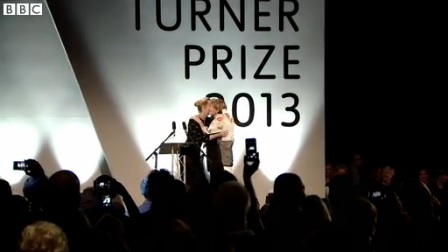
Installation artist Laure Prouvost has won this year's Turner Prize for her piece Wantee, which takes the audience in search of her fictional grandfather.
It was announced by actress Saoirse Ronan at a ceremony in Londonderry, the UK City of Culture 2013.
Prouvost beat humorous artist David Shrigley, painter Lynette Yiadom-Boakye and performance artist Tino Sehgal to take the £25,000 prize.
"I'm not ready, I didn't expect it at all," Prouvost said on stage.
"Four incredible artists here with me and the show. I thought 'It can't be me,' - I was sure it was not me. So thank you everybody," she said, as her baby daughter was brought on to the stage by Ronan..
WHO IS LAURE PROVOST?
Born in Lille, France in 1978
Lives and works in London
Studied at Central Saint Martins and Goldsmiths College in London
Awarded the MaxMara Art Prize for Women in 2011
Her work combines installation, collage and film
In her own words: "The power of suggestion and imagination is something I love to play with."
The French artist, who lives and works in Britain, thanked organisers for accepting her into the art scene.
"Thank you for adopting me, thank you for having a French one here," said Prouvost, 35, who also won the fourth Max Mara art prize for women in 2011.
"I've been here so many years and I feel adopted totally now by the UK, thank you."
Judges found Prouvost's piece, which was commissioned for this year's Schwitters in Britain exhibition at Tate Britain, "unexpectedly moving".
The panel said the film, which played in a room styled like a tea party, was "outstanding for its complex and courageous combination of images and objects in a deeply atmospheric environment".
It explored the lasting legacy of artist Kurt Schwitters through a fictional grandfather, who she had imagined to be a conceptual artist and one of Schwitters's close friends.
It was named Wantee, in honour of Schwitters's companion who had a habit of asking "Want tea?".
"It is a conversation about this idea of reality and fiction and what is true and what is not, and where it blends," Prouvost told the BBC's Arts Editor, Will Gompertz.
"I love the idea that everyone creates their own vision of everything you see. Maybe for me first it was not being English, I misunderstood things."
She continued: "Everyone creates his own story, even from a very abstract painting. Anything can really be understood differently with time, in 20 years what does this work mean?
"I think misunderstanding makes your imagination go further."
Previous winners of the Turner Prize include Damien Hirst, Antony Gormley and video artist Elizabeth Price, who took last year's award.
It was established in 1984 to celebrate new developments in contemporary art and is given to a British artist under 50, who judges believe has put on the best exhibition of the last 12 months.
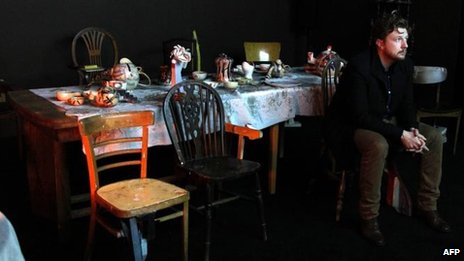
Prouvost said her installation was "a conversation about this idea of reality and fiction"
Works by all four shortlisted artists have been on display in the grounds of an old army barracks at Ebrington for the past month, the first time the annual art event has been held outside England.
This year's jury was chaired by Tate Britain director Penelope Curtis and includes the curator Annie Fletcher and the writer and lecturer Declan Long.
Commenting on Prouvost's installation, judges said: "Building on personal memory, it weaves together fact, fiction, art history and modern technology.
"Using film in a completely contemporary way, she takes viewers to an inner world, while making reference to the streaming of images in a post-internet age."
Prouvost graduated with a Fine Art degree from renowned British art college Central Saint Martins in 2001.
Alex Schady, who currently leads the BA course at Central Saint Martins, called her win "really exciting".
"The work has a quirky use of humour and combines complex narratives with a strong sense of storytelling to produce a body of work that is both surprising and unpredictable," said Schady.
"She is a very deserving winner and I'm delighted that her work is receiving such positive public attention."
Each of the other shortlisted artists will receive £5,000, and the Turner Prize exhibition will be on display at the Ebrington Barracks until 5 January.
The ceremony was screened live on Channel 4, presented by Lauren Laverne.
Prouvost told Laverne her baby daughter Celeste would not hamper the celebrations.
"We'll go dancing," said Prouvost. "She loves it when it is noisy."
記事はこちら⇒ http://www.bbc.co.uk/news/uk-northern-ireland-25175225
投稿者 unicon : 09:56
2013年09月12日
Mainland designer taps Kickstarter for laser-cut homeware collection 【scmp.com】
※この記事はセントマーチンズのデザイン系コース(Fashion, Graphic, Product, etc)への進学を希望する方に是非読んでもらいたいので日本語の解説を挿入しています
Zhang氏(現在上海在住)はChina Academy of Art卒業後、Lenovoに就職。数年間の就労を経てセントマーチンズのMA Industrial Designに入学した。「別世界の言葉」にまごつき、最初はへんてこりんにしか見えなかった奇妙奇抜なデザインやインスタレーション。好きになれなかった。
セントマーチンズ時代、distinction(優)をもらえずに終わったプロジェクトの欠点を見直して世に送り出し最初の成功を収めたのがMirror chairs(鏡の椅子)。セントマーチンズ卒業から3年を経た今、彼は新たな挑戦を仕掛けた。
Mainland industrial designer is using crowd-funding to make his dreams of a new generation of cutting-edge homeware a reality
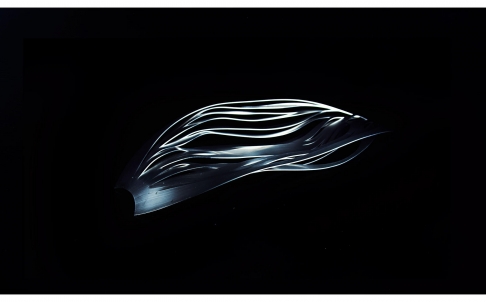
Zhang's computer-generated designs range from spiky chairs to trays that resemble the grooves on a whale's throat.
Zhang Zhoujie is about to take a great leap. He is set to become the first industrial designer from the mainland to use crowd-funding platform Kickstarter to create a collection inspired by zeroes and ones.
A champion of digitally generated designs, he aims to raise about US$15,000 on the site to fund his stainless steel "digital vessels", which are laser-cut, sculptural pieces with a futuristic bent. His campaign is scheduled to start this week.
But at Digital Lab, his studio in Shanghai, the 29-year-old Ningbo native is grappling with a request for an interview via Skype. One would assume, because he works closely with computers to produce "logical patterns" to shape objects, that he surrounds himself with the latest technology.
Not so. "I use a camera to control a laser-cutting machine, but I don't have a camera on my desktop," he says with a laugh. "I have a very old computer."
When Zhang realises that the powers of the internet would allow him to show off his studio and creations, he says, "Hang on, I'll Skype from my phone." Five minutes later, he is seen at a large table full of digital vessels.

Zhang is perhaps best known for his Mirror chairs, insect-like reflective pieces that are custom made to mould to each owner's bottom perfectly. But he hopes to kick-start his latest collection with an arty, stainless steel tray that, from some angles, resembles the accordion-like throat grooves of a baleen whale.
Kaleidoscopic shapes dominate the rest of his collection. The designs are guided by rules that Zhang encodes in a program, but the vessels also require human craftsmanship, making them unique. A computer-generated pattern is first laser-cut from a sheet of paper, which Zhang folds by hand to create a 3-D shape. The best, or most feasible designs are developed into vessels using sheets of steel.
Although Zhang has produced about 35 different shapes and sizes, he says some two-dimensional computer designs have simply not been possible in 3-D form. "More than 15 - no, more than 100" have failed, he says. "Sometimes we can't fold the shapes into containers."
Little wonder that Zhang's parents baulked initially at his career choice and the desire to go it alone, unlike many of the 10,000 design graduates who emerge from the mainland's 400 design programmes every year to be snapped up by technology firms.
"In the beginning my parents couldn't understand why I would want to work somewhere that's like a factory, when I could have a very good job elsewhere," he says. "But now they realise it's a dream and that I'm in the generation that does what it wants to do. And should do."
Zhang studied at the China Academy of Art and then worked for Lenovo (dreaming up mobile phones) before pursuing a master's degree in industrial design at London's Central Saint Martins College of Arts and Design.
In the three years since graduating from Saint Martins, he has finessed what he proposed as a second-year project.
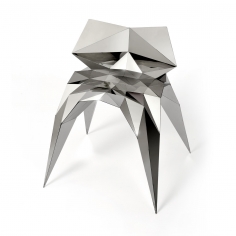
"Some liked it; some didn't," he says, referring to tutors who debated the merits of his computer-generated designs. "One said I needed to make a chair with that typology so people could see how it could be functional."
Which is what he did. But by the time Zhang graduated, his first furniture piece was still impossible to make. "That's why I didn't get a distinction," he jokes.
Any design flaws have obviously been fixed: to date, he has sold 25 Mirror chairs. Bundshop.com - an online retailer and platform for contemporary Chinese design - sells the chairs for as much as US$6,000.
Zhang showcased the chairs at Britain's largest design trade exhibition, 100% Design, in London two years ago. "They sold out in 20 minutes," says Bundshop co-founder Stephany Zoo.
They hope to have a repeat success at this year's edition, starting on September 18. "We will be launching a series of seven vessels [at the London trade show]," says Zoo.
She says his Kickstarter effort will be a first for any mainland industrial designer. "There have been other Chinese designers, but for fashion only."
Bundshop, which is supporting his campaign, will have exclusive rights to the vessels, priced at US$180 to US$250 each.
Price, function and comparative ease of production make the digital vessels more suitable than the chairs for the Kickstarter campaign, both say
"The chairs are always limited-edition and I have very limited production ability," Zhang says, adding that each Mirror takes a month to make. "But the vessels are daily objects and I can produce as many as people need."
The money raised would go towards cutting the production price, he says. "I could ask factories to make more. Right now, I send them one by one … And I could employ more professional craftsmen to help me make these objects."
He employs six people in a three-storey house in Songjiang, Shanghai; the ground floor is his factory, the second his private quarters and the top floor his studio.
On the Skype screen, his assistants can be seen huddled in conversation as their bespectacled boss shows off shelves of products ready to be shipped to buyers, mostly Westerners.
"I combine an Eastern view with Western design methodology, so Westerners understand what I'm doing," Zhang says. "They are willing to have creative objects in their home; in China not many people are into this kind of thing."
But tastes change. Having young designers learn from him, at his studio and in classrooms, will surely contribute to mainlanders' changing artistic sensibilities: as well as two craftsmen and an intern, Zhang employs three assistants from the Shanghai Institution of Visual Arts at Fudan University, where he now teaches "public art" part-time
Zhang's own training began early. He was taught traditional painting from the age of six.
"My father is a calligrapher, so I learned Chinese fine art," he says.
When his father offered to send him abroad, Zhang first applied to the Art Centre College of Design in California but was rejected because his English-language skills weren't up to standard.
Although he made it into Central Saint Martins, Zhang discovered he was befuddled by language of a different kind.
"I didn't understand the weird designs and installations being produced, which to me were not very attractive," he says.
"But after a year I understood fully that design is not just about style or making a certain shape ; it's more about the meaning behind the object, the narrative, something deeper.
“Design”というのはスタイルやある形を作り上げるということだけではない、という事がセントマーチンズに入学して1年経った頃にようやく理解できた。デザイナーの意図や最終形に至るまでの過程やストーリーなど、深いところに隠された秘密を考え、理解することが“Design”という言葉に含まれているのだ。"
So what's the story behind his work? "I spent that year clarifying my design philosophy, which has to do with spontaneity and respecting nature," he says.
"Nowadays we can simulate wind, water, natural phenomena. I found digital technology can kind of simulate nature; it's mathematics, and nature is mathematical."
Moving through his studio with his phone in hand, Zhang shows his latest creation - a table that took him three years to develop. Which leads to the question of whether he is experiencing fewer failures now than when he started experimenting with computer-generated design.
"No," he says. "I am having more and more failures as I explore new areas. It's kind of an exploration."
The errors are all part of the toil required to "come up with something important and revolutionary one day". "I hope to inspire many people," he says.
He mentions two industrial designers whose work has influenced his own: Ron Arad of Israel ("he combines art and design") and Ross Lovegrove of Britain ("very futuristic ... and he designs with conviction").
"The older generation have a past," Zhang says. "I can see how they developed their ideas, their path."
He struggles, however, to come up with names of compatriots. "[I can think of inspirational] architects, yes, but industrial designers, no," he says finally, lapsing into halting English. "They are good at commercial products and develop good functional objects. But industrial designers … very deep? No."
That said, Zhang insists he no longer sees himself simply as a Chinese industrial designer.
"I'm not too concerned about nationalities or boundaries," he says. "I see myself as an international designer."
“英語で苦労した”というのは単なる‘英語力’というのではなく、‘セントマ哲学に基づいたアート英語’に苦労したということです。
この違いを理解できるくらい、日本人の英語力が向上することを願うばかり。
投稿者 unicon : 12:03
2013年07月02日
【宝くじ一等賞を当てた4人】 In fashion's famous footsteps 【thisisnottingham】
※この記事は是非読んでもらいたいので所々日本語訳を挿入しています
THEY are following in the footsteps of Stella McCartney, Katherine Hamnett, Matthew Williamson and Alexander McQueen to study at one of the most prestigious fashion colleges in the country.
Four New College Nottingham graduates have been selected by Central Saint Martins College of Arts and Design in London.

Alexander Bucko and Adam McKee, both 19, will study for a BA degree in fashion design womenswear, while Alex Watts, 20, and Will Scarbourough, 19, will study for a BA in fashion communication and promotion.
For their tutor Caroline Jackson, to have four students selected is a big achievement.
"I've been teaching here for four years and this is the first time I've got anyone into Central Saint Martins to study fashion, 私はこの学校で4年間教職に就いているが、セントマーチンズのファッション学部に生徒が合格したのはこの4年で初めてのことです。" says Caroline, who teaches fashion on the diploma in foundation studies in art and design at the NCN campus in Stoney Street.
"I keep saying to them that it's like winning the lottery. I think there were ten places open to UK students on the womenswear course and they got two of them. セントマのBA Fashion Womenswearに合格するのは宝くじ一等を当てるようなものといつもファウンデーションの生徒に言っていました。イギリス人は10人しか合格できないBA Fashion Womenswearに2人も合格しました。It's good for us here at NCN because once they've had students from us, they will look more favourably on us in the future."
Much of the students' portfolios contained work from their final projects which they exhibited last week. Alexander Bucko from Arnold, who showed off his Japanese-inspired designs, says of his successful application: "It makes me feel like my work has potential and it's given me the best opportunity there is to get into the industry.
"My parents are over the moon because they know how much I wanted this and have talked about it."
University alumni include musicians Jarvis Cocker and PJ Harvey and actors Pierce Brosnan and Colin Firth.
But the students know they've got a tough few years ahead.
Adam McKee says: "I think it's going to be more intense than college has been. I really respond well to creative people so I'll thrive under the pressure."
The students fulfilled a project brief before being invited to London to show their portfolios and going through a rigorous interview.
Alex Watts, from Normanton on the Wolds, wants to go on to work in magazines or public relations.
She says: "It's very exciting but also very nerve-wracking. We've been told the first term will be the hardest of our life."
Will Scarborough, 19, who only recently found a passion for fashion and photography, hopes that the course will bring out the best in him.
He says: "Being surrounded by creative people brings something out in me that I didn't know was there."
投稿者 unicon : 12:28
2013年06月12日
Milliner Rosie Olivia is turning heads - and fans include members of the Royal family and the Made in Chelsea cast 【LANCASHIRE LIFE】

Rosie Norman is happy to let success go to her head – after all, she’s making hats for some of Britain’s most famous women.

With her workshop in a converted garden shed and her showroom in her sister’s old bedroom, Rosie doesn’t exactly possess all the trappings of success. However, she has already made a name for herself in the north west and she now has the Royal seal of approval for her bespoke designs.

Her customers include Princess Beatrice and, more recently, the Duchess of Cambridge’s sister Pippa Middleton. Being worn by royalty was a fantastic endorsement - you don’t get much more high profile than the Christmas Day service at Sandringham. ‘I was flattered and excited to get such a chance so early in my career,’ says Rosie. ‘I’m honoured to have my brand associated with Her Royal Highness.
‘Princess Beatrice is well known for wearing eye-catching hats and I am thrilled to be able to add to her collection. She’s got a reputation for being wacky, but I think she wanted to tame it down a bit, and she really did look great. When I watched it on TV with my family and saw her wearing my hat we popped the cork on a bottle of champagne to celebrate!’
Rosie, who attended King David School in Childwall and Liverpool College, has always been artistic but it wasn’t until she studied decorative arts at Nottingham Trent University that she tried millinery. She knew it was for her.
She produced a range of hats for her degree and she got a first. Then Rosie completed a further course at Central Saint Martins before taking internships with top milliners Philip Treacy, Stephen Jones and Victoria Grant.
After learning about the business side from top people in the trade, she was convinced she could make it on her own. Now just 24 and with two years under her belt, Rosie Olivia Millinery is really taking off. Her creations are now stocked in Fenwick’s of Bond Street as well as selected outlets near her home in the smart Liverpool suburb of Woolton.
Channeling her infectious personality through her hats, Rosie’s designs revel in the very British heritage of wearing hats and draw stylish inspiration from modern and vintage trends. Her clients range from 20-year-olds to women in the 70s and she uses colour and luxury materials in an exciting blend which results in wearable statement pieces for daywear and formal occasions such as weddings and Ascot.
All are handmade by Rosie in her workshop – these days, a very upmarket garden shed – and clients come for consultations at her family home.
‘At some point I’m going to have to move to London, but at the moment I can keep control of my business from here. It’s a 24/7 job, but very exciting. I feel so lucky to be doing something I love and it’s a great feeling when a client is delighted with something you have created,’ adds Rosie.
She produces two collections a year and for winter, Rosie’s collection includes fedoras and caps in berry shades with hand beading. Her Spring 2014 collections is already organised, too, and features smaller hats in pastel shades.Rosie’s working hard on a special collection at the moment – for family attending her sister’s wedding. For now, she’s keeping her ideas under her hat but it’s sure to be a stylish affair.
The Royal connection
Rosie has been supported by the Prince’s Trust as part of the youth charity’s Enterprise programme which gave her valuable advice when she set up her company. This connection gave Rosie the chance to meet Princess Beatrice and she was invited to create a bespoke piece for her to wear.
Working with the Princess’ stylist, the hat was designed specifically to complement her outfit, and was made from black velour felt, trimmed with a simple bow crafted from Rosie Olivia’s trademark hand-woven lace.
And since then she has made an attention-grabbing hat for Pippa Middleton who wore it to a society wedding. The word is getting out. Perhaps the Duchess of Cambridge will be the next customer?
Visit her website www.rosieolivia.com call 07780 668885, or get in touch by email at rosie@rosieoliviamillinery.com to book a consultation.
Seen on TV
Keep watching the new series of Made in Chelsea for Rosie’s bespoke hats worn by Ashley James and Ollie Locke for whom she made a personalised black fur cap with his initials picked out in Swarovski crystals.
A cap on it
Women are no longer fascinated by fascinators, according to celebrity milliner Philip Treacy. The tiny titfers have become so cheap to make discerning ladies are going back to ‘proper hats’ like those made by Rosie. Fascinators have already been banned at Royal Ascot.
投稿者 unicon : 09:32
2013年05月31日
Central Saint Martins' Reveal 【VOGUE UK】




MAO USAMI walked away as winner of the L'Oreal Professionel Award at Central Saint Martins' BA graduate fashion show last night - a strong and varied offering from this year's crop of students that played to pastel or neon strengths and more often than not wandered into homespun and crafty realms.
"I'm proud of them all for doing it. It requires being fearless which I wholly believe in. They're young and courageous. There was some real attitude and balls there, it felt exciting and I wish them well," prize-giver of the night and Celine creative director Phoebe Philo told us post-show. She was joined by master of ceremony Giles Deacon in her praise.
"It's incredible to get a collection together really when you're still at limited means but there was some super good creativity and something for everyone," he enthused.
Womenswear designer Usami showcased a collection that was causal to the core and riffed on American sportswear and PE kits and showed us that socks are the new shoes - the way to wear them is too long at the toe so that they attempt to trip you up as you walk (luckily no models made that mistake on the catwalk). Usami was joined by fellow students Narae Park and Giacomo Cavallari in the end-of-year celebrations, both of whom scooped second and third prize spots respectively - the former for bottle-soled slippers, bucket bags and stiff floral shapes, and the latter for glossy colour-blocked menswear accompanied by cutaway shoes to reveal jazzy-jaunty socks.
It was a night of fashion that teased the senses in every which way - from the humour of stuffed toy animal heads among Akiko Nei's collection and brick shoes from Xu Yuan Xin to the extensive and elaborate use of texture, embroidery and the touch of the human hand.
"The use of the sound in the clothes, mixed with the textures for amazing blends," noted CSM alumnus and designer Mark Fast. "I loved the easiness and the overall continuity of the show as a result."
And one of its key themes was hand-craftsmanship - ensembles that were underpinned by nostalgia, making do and mending, recycling and largely rejecting the cyber gloss and body-consciousness or techno-prints that we have so largely seen sweep across the student board in the past. Here, boys were playing at being frou-frou drag girls drenched in drama (James Buck), girls were playing at being punk rock gypsies (Matthew Bovan), and everyone was happy to make a very big statement - be it the broad shoulders of the great graffiti numbers from Beth Postle, the pretty quilted neon florals of Yoshimi Mita's serious silhouettes or the accessories to end all accessories (huge silver blocks, discs of sculptures) at Samuel Yang.
School's out for another summer - and with it a whole new set of ideas and designers to keep an eye on.
2013年05月07日
GALLERY: Swarovski X CSM jewellery students 【Professional Jeweller】

Swarovski has teamed up with third-year Central Saint Martins jewellery students, encouraging them to push the boundaries of design using Swarovski Elements and Swarovski Gems, with the theme of Fiction and Fanstasy. Design by Emily Wright.
記事はこちら⇒ http://www.professionaljeweller.com/pics-12935-gallery-swarovski-x-csm-jewellery-students/
投稿者 unicon : 11:10
2013年03月22日
Winner: Simone Rocha, recipient of the first ELLE/Cointreau Bursary【ELLEUK.COM】
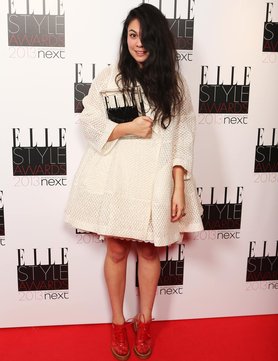
You will have read in ELLE’s April issue (on sale now), that Simone Rocha was chosen to receive the ELLE/Cointreau Bursary, a fund of £100,000. The prize was launched to help fledgling London designers grow their labels from cult fashion favourites to serious international businesses.
ELLE editor in chief, Lorraine Candy, says: ‘This is a groundbreaking award that will help Simone to expand her business and meet the ever-growing demands of her fans. ELLE has a proud history of championing young talent and now we can help them grow financially too.’
As part of the ELLE/Cointreau Bursary, the designer will serve as creative director for Cointreau. She will also be blogging exclusively for ELLE, giving us an insight into what really goes on behind-the-scenes at her label as she prepares her spring / summer 2014 collection. In the meantime, here are 10 things you need to know about Simone Rocha.
1. Fashion is in her genes. Her dad is London Fashion Week veteran John Rocha who always sits front row at her shows with mum Odette, and brother Max who puts together the soundtracks.
2. She graduated from Central Saint Martins in 2010 and was immediately spotted by Lulu Kennedy who invited her to show at London Fashion Week as part of Fashion East in the same year.
3. Simone’s pieces are sold in some of the most influential boutiques in the world, including London’s Dover Street Market, Milan’s 10 Corso Como and Paris’ Colette.
4. ELLE was the first magazine to put Simone Rocha on the cover - remember the incredible green organza dress that Lady Gaga wore for the January 2011 issue?
5. Her celebrity following includes Alexa Chung, Chloe Moretz and Rihanna.
6. Simone won the New Designer Award at this year’s ELLE Style Awards, presented by Arizona Muse, and she collected it dressed head-to-toe in her spring/summer 2013 collection.
7. One of her ‘inspiration’ books is ‘Pony Kids’ by Perry Ogden.
8. She was born in Dublin in 1986 – and she retains her brilliantly rich Irish accent.
9. Her autumn/winter 2013 collection is entitled ‘Respect Your Elders’ and was inspired by her late Irish grandmother, Margaret Gleeson, and her Chinese grandmother, Cecilia Rocha.
10. Her design heroes are Rei Kawakubo, Yohji Yamamoto, Martin Margiela, Raf Simons and John Rocha.
Find out more about the ELLE/Cointreau Bursary and read Simone’s blogs
See the Simone Rocha autumn/winter 2013 collection.
See Lady Gaga wearing Simone Rocha on the cover of the January 2011 issue of ELLE.
http://www.elleuk.com/fashion/news/simone-rocha-elle-cointreau-bursary-prize-winner#image=1
投稿者 unicon : 09:57
2013年03月18日
John Galliano Not Taking Up CSM Teaching Post 【VOGUE UK】
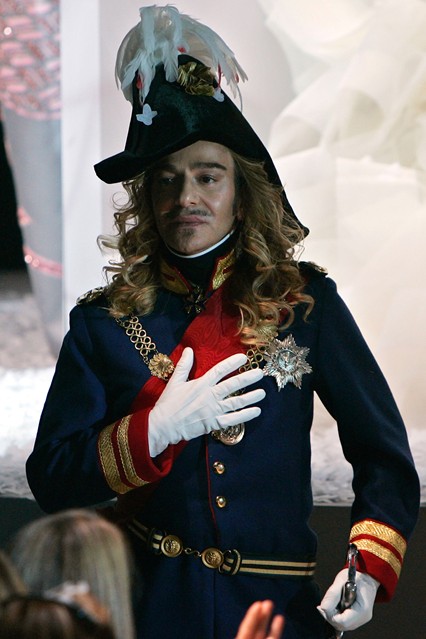
JOHN GALLIANO will not be taking up a teaching post at Central Saint Martins, we can confirm. This comes despite reports to the contrary, which were further ignited when he paid a visit to the school earlier today.
The designer stopped by to comment on the work of selected second year BA Fashion students - who had been working on a themed project previously set by Galliano. A spokesperson for CSM confirmed that he does not currently have a teaching post at the school, nor does he have plans to assume one in the future.
"For several years second year students from Womenswear at BA Fashion CSM have been set a project on a theme set by John Galliano," they told us. "This year the theme was the paintings of Edward Hopper. John Galliano came in to comment on the designs of 12 selected students who had earlier presented the strongest work. John Galliano does not have a teaching post at Central Saint Martins."
Reports were first sparked that the designer was interested in taking up teaching at the art and design college back in February. Oscar de la Renta - who had welcomed Galliano in to his studio for a temporary residency - told the New York Times that: "John's not backstage - he is going to London tomorrow to talk to Saint Martins school about teaching there."
投稿者 unicon : 10:14
2013年02月26日
Liora Lassalle's upcycling alchemy 【Telegraph.co.uk】
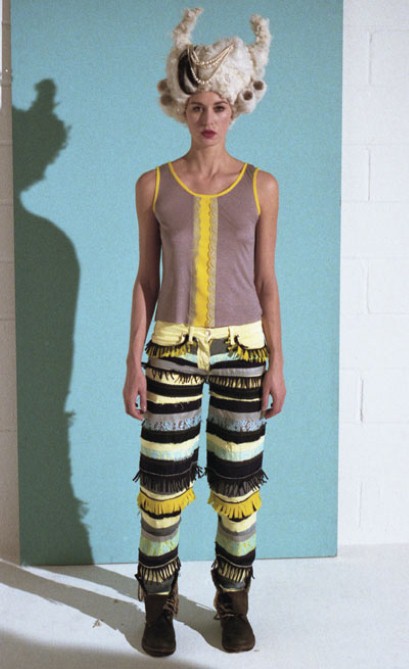
When Liora Lassalle won Re-Source , a competition run by the British Fashion Council's eco platform, Estethica, last year, she was handed a pile of discarded bin men's uniforms and told to create a catwalk collection. Lassalle, 24, a Central Saint Martins graduate, was thrilled. "It was really exciting when I got the delivery. I was given hi-vis reflective and padded jackets, navy sweatshirts and T-shirts, and plastic stretchy jackets. I love using bright colours, so the fact that I could recycle luminous fabrics was brilliant." Her 10-piece capsule collection for autumn/winter 2013 was unveiled at the Estethica stand during London Fashion Week earlier this month, and an accompanying video showed the clothes in motion. Limited numbers of the collection will go on sale this month at yoox.com, from £153.
The competition, run in conjunction with Central Saint Martins and Veolia Environmental Services (a recycling and waste management company), stipulated that students create clothes from sustainable sources for their graduate collections. Twelve students entered. Lassalle impressed the panel with her energetic designs, convincing them that she deserved the prize of Estethica mentoring and the opportunity to produce an upcycled collection. "I wanted to use natural fabrics, so I worked with hemp and jute," she says of her final collection for Central Saint Martins. "I used a thick hemp canvas from Cornwall, a beautiful fabric that felt down-to-earth, and hand-printed it with fluorescent paints."
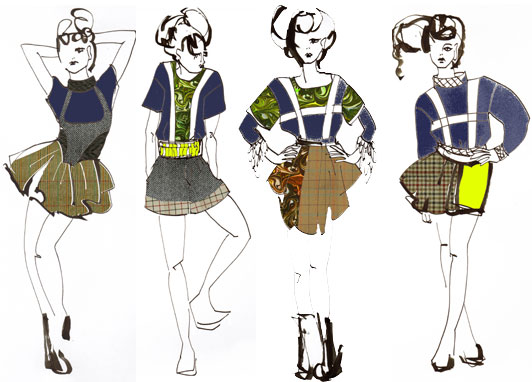
Liora's designs for her autumn/winter 2012 using offcuts of luxurious fabrics alongside upcycled bin men's uniforms. Photos: Liora Lassalle.
Recycling is second-nature to Lassalle. "We have a lot of antiques dealers in my family. My dad is a hoarder - doorways in his house double as hanging spaces for rows of shirts, his corridors are rammed - and I like to use things that are lying around." For her graduate collection Lassalle embroidered natural raw hessian jackets with plastic bags. "I had so many plastic bags in my house, so I cut them into strips and used them like raffia, as a thread." Empty beer cans abandoned by housemates in her east London flat were cut up, embossed, and sewn on to dresses.
Her Re-Source '18th-century-inspired' capsule collection, produced under the guidance of the ethical fashion designer and Estethica curator Orsola de Castro, employs similarly ingenious methods. Each item upcycles Veolia-donated materials and combines them with offcuts from de Castro's fabric collection, amassed over the course of her career from design houses all over Europe. A quilted navy jacket, originally a lining, has been combined with Lycra panels and restitched in neon-yellow thread, with vintage French lace appliquéd over stains on the shoulders. A pair of trousers fashioned from reflective strips sits alongside a jersey T-shirt embellished with neon ruffles and pearls.
"I thought the contrast of the bin-man fabrics with the pearls was interesting. It was a challenge because although the items had been cleaned they were covered in stains, so I had to find the best bits," Lassalle says.
Her biggest test has been adapting from creating one-off pieces to a line of 50 near-identical pairs of jeans as a separate exercise for yoox.com. An Italian manufacturing company donated 104 pairs of faulty jeans, which Lassalle shredded and sewed back together in horizontal strips. De Castro says her idea is "genius. It can be done with any material, and it's a creative way to use unsold garments." Filippo Ricci, the co-founder of Estethica, agrees. "Liora integrates materials from different origins to make everything fit in a single piece. That is not an easy achievement."
http://fashion.telegraph.co.uk/news-features/TMG9887935/Liora-Lassalles-upcycling-alchemy.html
投稿者 unicon : 11:06
2013年02月19日
Central Saint Martins MA Fashion Show 2013: Elish Macintosh, Jaimee McKenna & More 【graziadaily.co.uk】
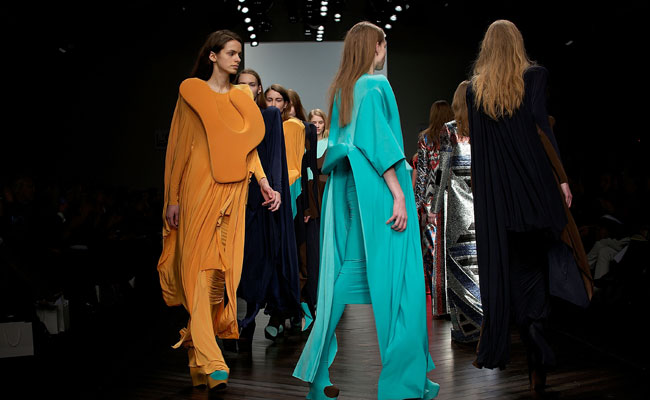
London's deserved reputation for nurturing more 'big new things' per square mile (or season!) than any other fashion hub in the world was again proven last night with the Central Saint Martins MA graduate show. The course is infamously no breezy picnic in the park, and the living legend of fashion teaching, Professor Louise Wilson, is the woman who has made it happen for the likes of Christopher Kane.
The popular Scot designer was in attendance on the front row yesterday evening (alongside Lulu Kennedy, Tim Blanks and Hilary Alexander) to present the L'Oreal Profesional Bursary Chloe Award. If you aren't familiar with some CSM's prestigious alumni, let's recap: Alexander McQueen, Jonathan Saunders, Simone Rocha, Mary Katrantzou... you name a top designer on the LFW schedule this season and it's most likely they've undergone the CSM MA treatment. But who stood out as future talent on this February's runway? Well, in terms of menswear, you'd find plenty of Muslim-style 'thobes' over trousers, but we'd quite happily run away with one of Elena's Crehan's savagely beautiful lace, tufted furry, frilled knits - they seemed to be organically growing away from the body with every step.
Womenswear was of course a highlight for the Grazia team - and Elish Macintosh, with her black jersey column dresses adorned and harnessed in expertly knotted white ropes, was the evening's most triumphant, winning the L'Oreal award. But, you'll want to see the whole shebang, right? Scroll down for the womenswear designers in contention...
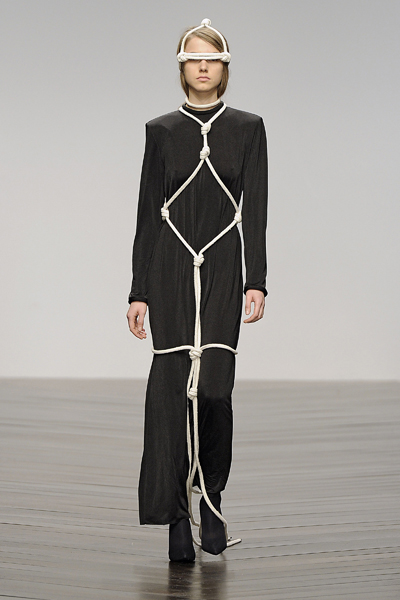
As explained above, Elish was the winning designer of the evening. And even made the fash pack chuckle, as one of her rope-covered peepholes that sat within the various black maxi dresses featured on the bottom! Oooh, cheeky.
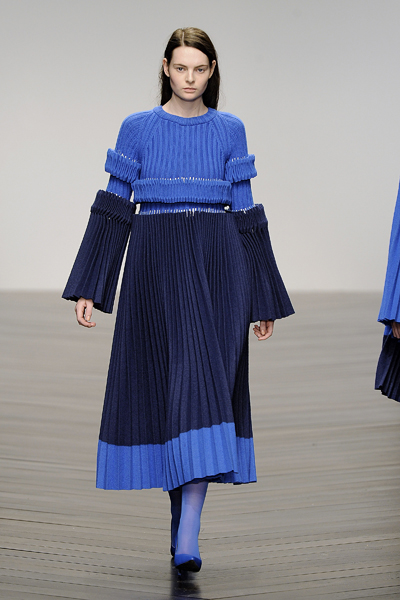
Like Pierot the clown, these beautiful pleated and layered cornflower blue and navy creations practically danced and bounced down the runway.
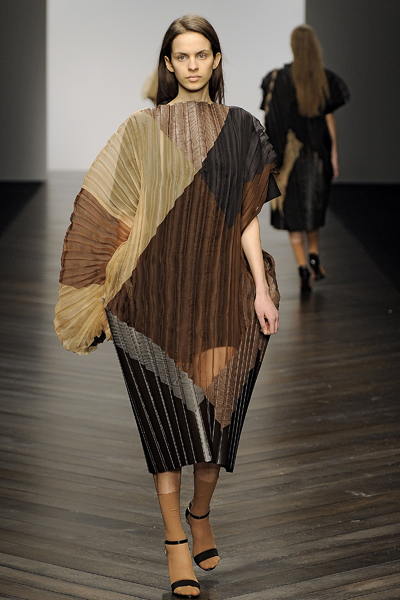
In a modern take on Issey Miyake, Jessica's earthy tones and clever leather bonded sections made super-size accordion pleats look new and fresh.
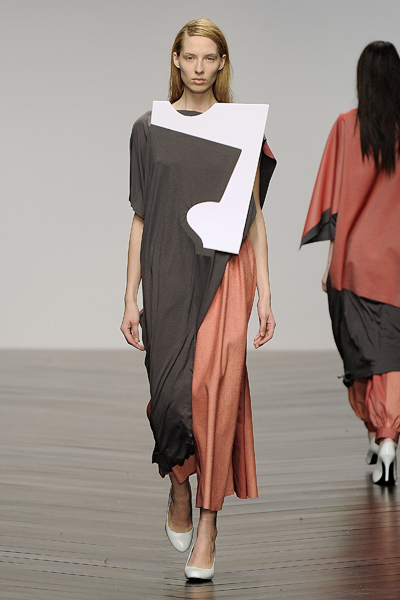
Cubist 3D shapes adorned these loose-fit draped dresses in a classic colour wheel of black, red and white.
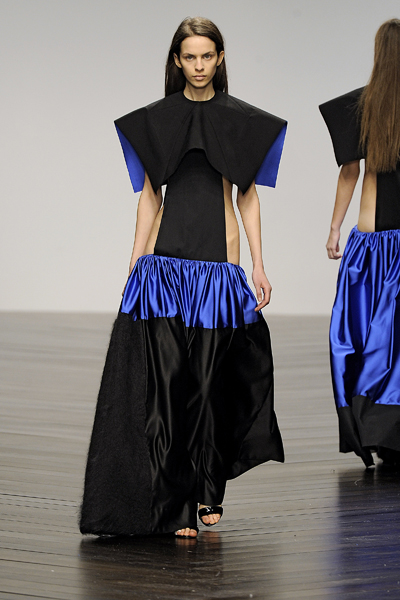
Rachel's dramatically ruched, folded and slit outfits were striking in black with slashes of bright cobalt blue.
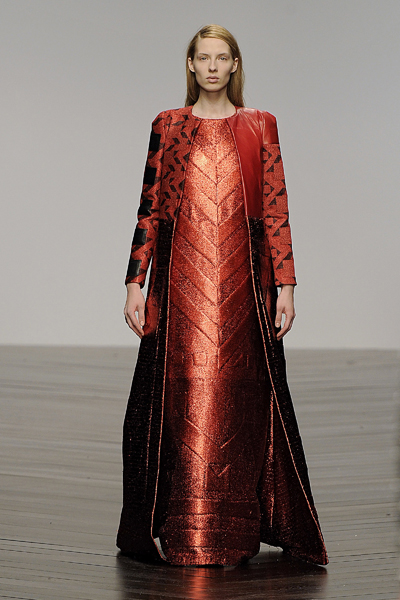
Like 1970s Christmas tree angels, Sadie's cone dresses were one part sci-fi, one part retro in the most sparkly of lurex, embossed and layered with leather.
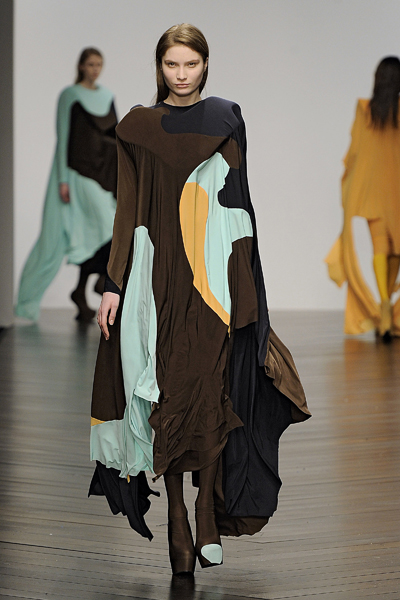
Also playing with 3d shapes away from the body Toma layered abstract moulds underneath her silky jersey colour blocked dresses.
http://www.graziadaily.co.uk/showreports/fashion-reports/central-saint-martins-ma-fashion-show-2013
投稿者 unicon : 12:03
2013年02月07日
It's Mine: crime prevention now cheap as (micro) chips 【wired.co.uk】
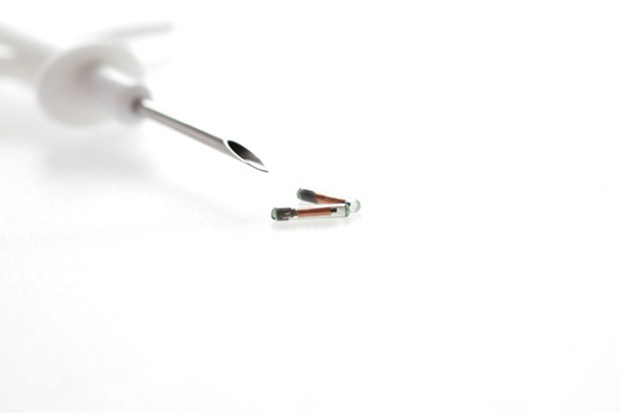
"It's a dog's life" has long been a phrase for hardship, but Alan MacFadyen believes your prized possessions are envious. MacFadyen is co-founder of new UK crime prevention company It's Mine Technology and he claims the common practice of microchipping now has the potential to turn the tables on petty crime.
It's Mine means this in a remarkably literal sense. It is taking the latest revision of tiny rice-size 8mm x 1.4mm pet microchips and shipping them with an applicator that allows them to be fitted into clothing, bags, briefcases, laptops, phones, tablets -- just about anything. The chips have a unique ID which customers register on Immobilise.com (the national mobile property register used by the police) and each chip has a 20-year lifespan. A tamper proof label is supplied with every chip as a deterrent to potential thieves and a cue to police officers.
This seemingly oddball idea has actually been a long time in the making. "More than 10 years ago I was a consult to Orange's Futurescape team which looked at technology up to 10 years out," says MacFadyen. "We looked at chipping then, but the technology wasn't there. Chips were 3-4x the size which made them obvious and risked damaging items. They were also too expensive."
Price is what It's Mine hopes will at last take the original vision mainstream. Whereas microchipping costs up to £30 per pet, It's Mine ships a chip and applicator for £12.99 with a subsequent additional chips costing £11.99.
But does it work? Certainly in pets the results are very strong, with the Dogs Trust reporting in 2011 that microchips were responsible for 32 percent of all owners' reunions with their lost animals. By contrast the current outlook for reuniting owners with their possessions is bleak. Transport for London (TfL) says on average one in four items found on the network is restored to its owner and the National Bike Registry points out that while 48 percent of all stolen bicycles are recovered only five percent are successfully returned.
Other perks? MacFadyen says if chipping became ubiquitous it would make thieves think twice because the chips are extremely hard to find, difficult to remove without damaging an item and would greatly impact the black market where a fear of chips in items would weaken demand. There is an upside to law enforcement too with officers easily able to prove items are stolen after an arrest and use their origin to better track crime patterns.
Paul Ekblom, professor of Design Against Crime at Central Saint Martins College and a former crime researcher for the Home Office, says the logic behind chipping is sound. "The product is an interesting and encouraging one because of the quality of the thinking and development process behind it," he explains. "It has been designed with close attention to the theories underlying crime science and the psychology of consumers and criminals. [There is] an interest in using research evidence and in generating further hard evidence of effectiveness and cost effectiveness, which is quite unusual for commercial products."
That said Ekblom argues crime prevention works best when people simply get the message that they must be more conscientious in their daily behaviour; something he says is a direct consequence of our relatively recent obsession with portable gadgets. "Undoubtedly there is now a steady movement towards property protection," he says "although it has taken a long time for manufacturers and service providers to admit [their role in] the problem and that their products have been 'complicit with crime' by being too easy to steal."
For It's Mine the battle will be in attaining wide acceptance, but the company is off to a good start. In its first full month's trading it has chipped £20m worth of instruments at the Royal College of Music, secured discounts for customers who chip items insured by Lark and New Moon insurance companies and agreed a deal to pre-chip all Jobeeny designer handbags. In addition to chips, It's Mine is also offering product lines in personal GPS trackers plus bracelets and key rings which alert you to separation from a paired Bluetooth device.
"The task of crime prevention can never stand still because we're in an arms race with adaptive offenders run against a backdrop of social and technological change," concludes Ekblom. "The only strategic response to keeping crime under control in the long run is to give designers… the capacity to out-innovate the criminals, and the manufacturers and organisations who may inadvertently or recklessly generate crime opportunities the motivation to make their products secure."
As it turns out diversifying use of pet microchips appears a surprisingly good place to start.
Correction: Article previously stated a bag of ten chips costed £11.99. A single additional chip costs £11.99, while a bag of ten costs £67.99
http://www.wired.co.uk/news/archive/2013-02/05/crime-preventing-microchips
投稿者 unicon : 11:37